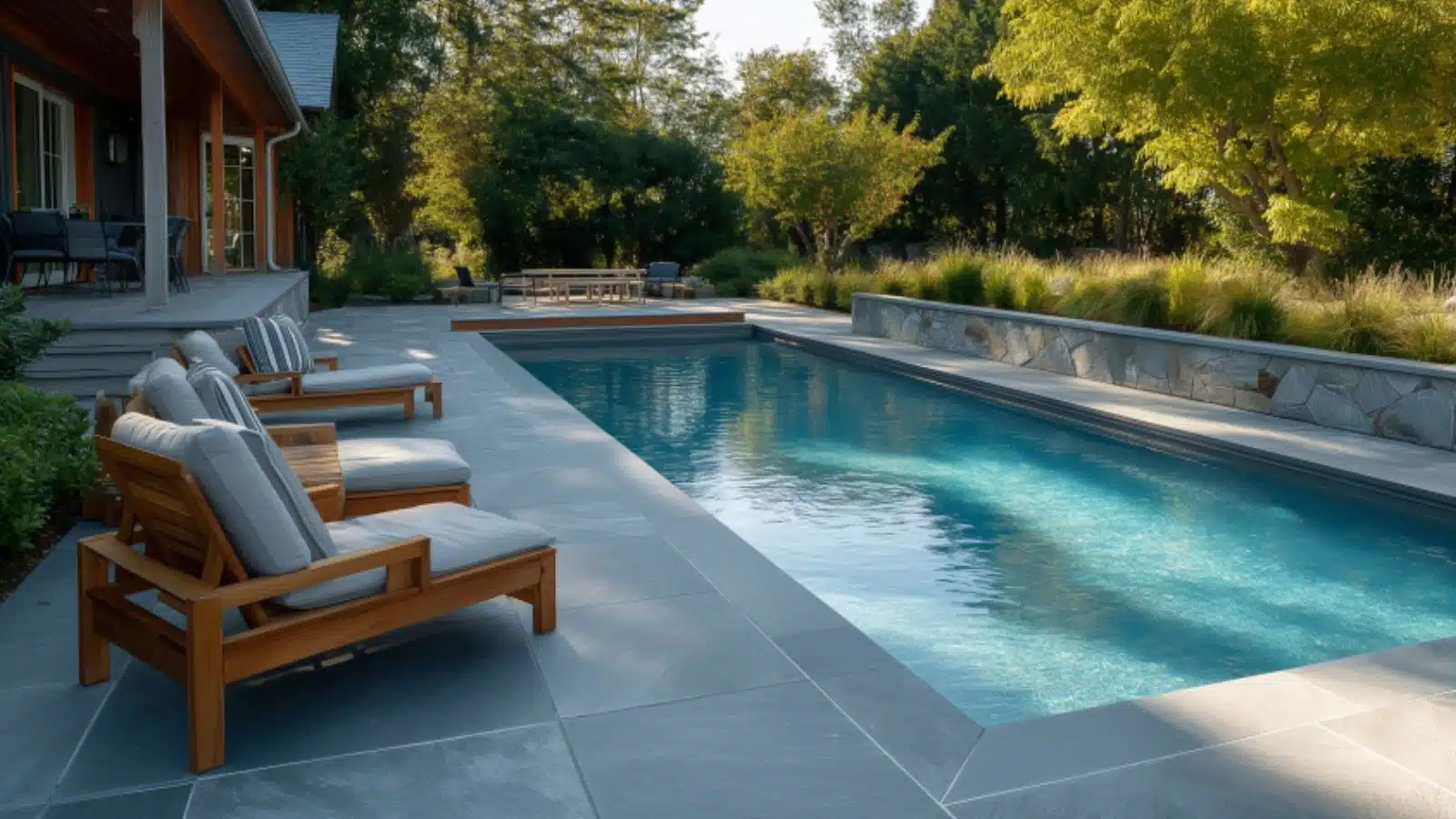Stone and Wood Decks Around Pools for a Rustic, Timeless Backyard Escape
Table of Contents
There’s something undeniably magical about rustic design—its earthy tones, tactile textures, and inviting warmth create a space that feels both timeless and deeply personal. And when paired with the cool shimmer of a pool, stone and wood decks offer an extraordinary contrast that brings serenity and sophistication to any backyard. According to a 2023 Houzz landscaping report, homeowners are increasingly opting for natural materials like flagstone, reclaimed wood, and river rock to design pool areas that feel like outdoor sanctuaries.
Whether you’re dreaming of an alpine-inspired hideaway or a Mediterranean courtyard, using stone and wood around your pool blends function with rugged elegance. These materials age gracefully, provide excellent traction underfoot, and blend beautifully into garden settings. But beyond aesthetics, this rustic pairing is surprisingly practical and customizable for different climates and budgets.
In this guide, we’ll dive into everything you need to know to design and build stone and wood decks around pools—from choosing the right materials to styling tips and layout inspiration. You’ll find layout comparisons, durability insights, and expert-approved safety recommendations to help you create a stunning poolside retreat that’s both functional and full of charm.
Why Stone and Wood Are the Ultimate Rustic Duo
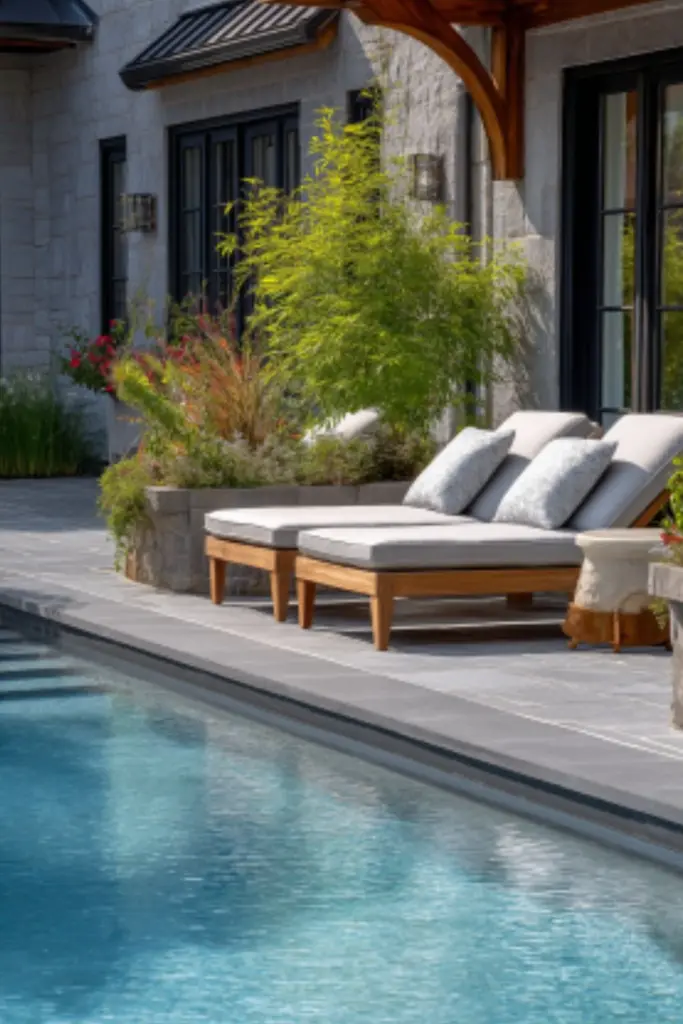
Combining stone and wood around a pool is a design choice rooted in nature and harmony. Stone offers permanence, strength, and texture, while wood adds warmth, flexibility, and classic appeal. Together, they create a balance that feels organic and deeply connected to the earth.
Stone surfaces—like flagstone, slate, or travertine—provide durability and non-slip textures, especially helpful for pool environments. These materials stay cool underfoot, resist water damage, and create a refined yet rugged look.
Wood, particularly species like cedar, redwood, or thermally modified pine, adds visual warmth and softness to contrast the hardness of stone. Depending on how you treat or finish the wood, it can offer a lived-in patina or a cleaner, more modern rustic look.
Stone and Wood Comparison Table
| Material Type | Pros | Cons | Best Use Case |
|---|---|---|---|
| Natural Stone | Durable, slip-resistant, visually elegant | Can be expensive, heavy to install | Pool perimeters and pathways |
| Hardwood (e.g. teak) | Water-resistant, long-lasting | High cost, needs maintenance | Decking close to water features |
| Reclaimed Wood | Eco-friendly, rustic charm | May need treatment for durability | Accent walls, built-in seating |
| Composite with Wood Texture | Low maintenance, consistent finish | Less natural appearance | Larger deck platforms |
Designing a Harmonious Layout with Stone and Wood
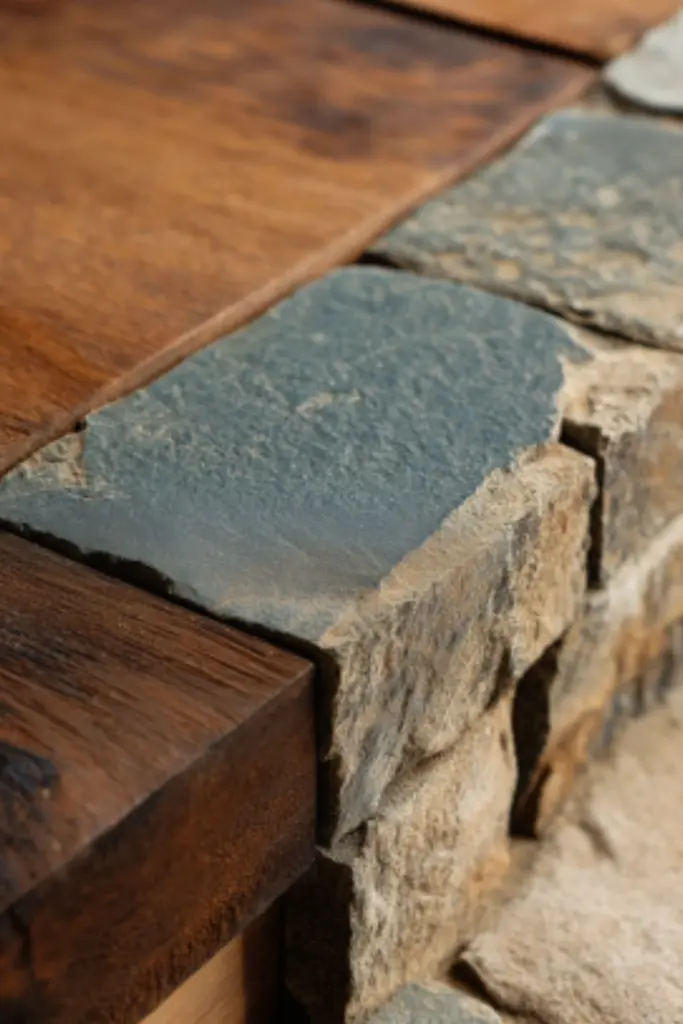
The key to a beautiful rustic pool deck is the seamless integration of stone and wood in a way that feels intentional and well-balanced. Rather than mixing randomly, consider function, traffic flow, and visual hierarchy.
Use stone as a grounding element around the immediate pool edge—it offers better water resistance and safety. Then transition to wood for lounge areas, dining spaces, or walkways. If elevation changes are needed, stone steps with wood railings or wood steps with stone risers can create visual interest and tie the design together.
Design considerations include the orientation of sunlight (wood can fade), access paths, drainage direction, and usage zones. Break the deck into usable “rooms”—a sunbathing area, a shaded seating corner, and a dining nook, each defined by the materials underfoot.
Layout Planning Table
| Zone | Material Recommended | Reason |
|---|---|---|
| Pool Border | Flagstone or slate | Non-slip and water resistant |
| Lounging Deck | Thermally modified wood | Comfort under bare feet |
| Dining Area | Composite or hardwood | Withstands furniture weight |
| Walkways/Paths | Pebble inlay or wood | Aesthetic flow and gentle transitions |
Choosing the Right Wood for Poolside Use
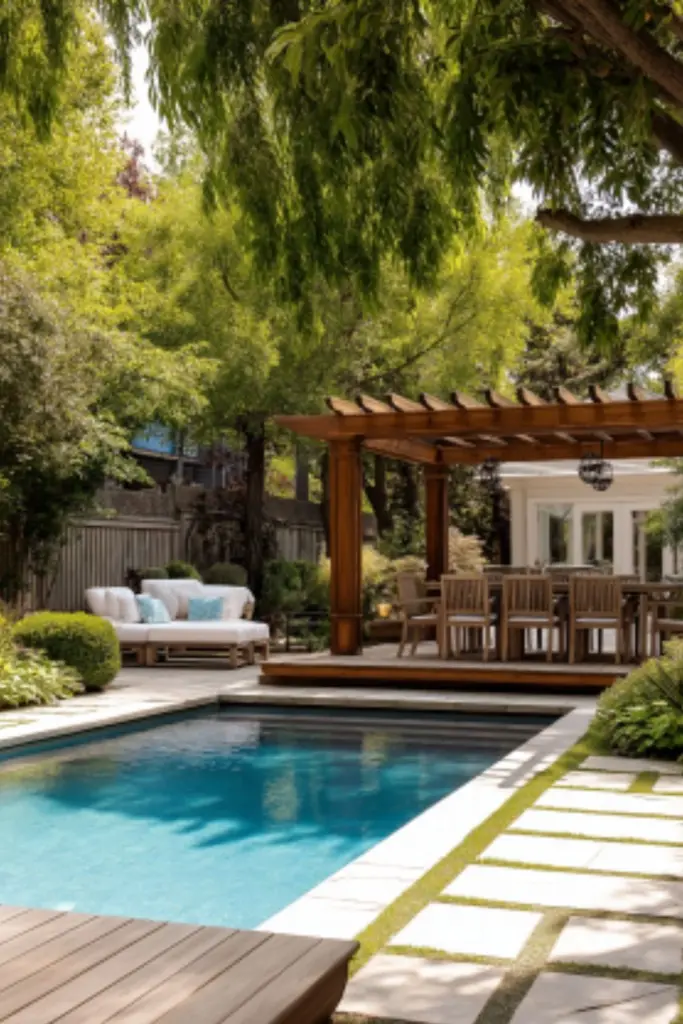
Not all wood is created equal when it comes to pool decks. Exposure to water, sun, and outdoor elements demands durable, treated, or naturally resilient wood types. Rustic charm comes not only from aesthetics but also from choosing materials that age beautifully and safely.
Cedar and Redwood are popular for their resistance to insects and decay. They’re lightweight, easy to work with, and develop a silvery patina over time. Teak is a luxury option with exceptional durability and resistance to warping. Thermally modified wood, a newer eco-friendly choice, offers superior moisture resistance without chemicals.
Also consider the finish—oils, stains, or sealants that enhance texture while protecting against sun and water damage.
Wood Selection Table
| Wood Type | Durability | Water Resistance | Maintenance | Rustic Appeal |
|---|---|---|---|---|
| Cedar | Moderate | Moderate | Moderate | High |
| Teak | Excellent | Excellent | Low | High |
| Redwood | Good | Good | Moderate | Very High |
| Thermally Modified Pine | Excellent | Very High | Low | Moderate |
Using Stone to Elevate Texture and Character
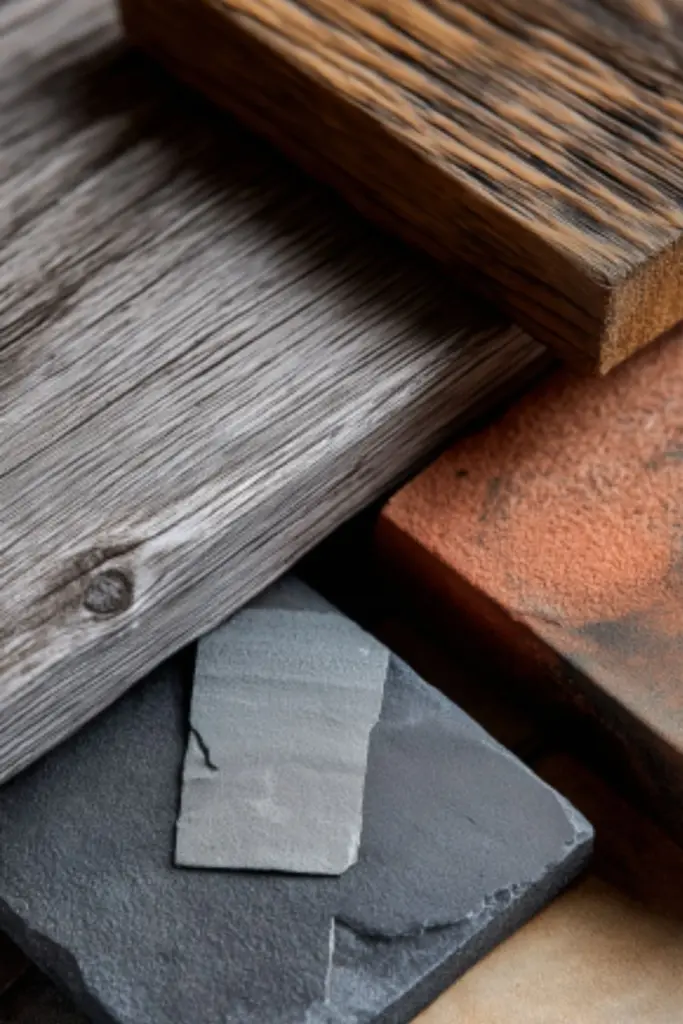
Stone is the backbone of rustic design—each slab carries history, texture, and individuality. Around a pool, it offers more than just good looks: it enhances safety and structural longevity.
Flagstone is a favorite for its organic shapes and natural clefts, perfect for creating irregular patterns that feel handcrafted. Travertine provides a more polished look while remaining cool and slip-resistant. Slate delivers deep, moody tones that contrast beautifully with warm-toned wood.
Stone can be used beyond flooring—think retaining walls, fire pit surrounds, or even built-in benches. Dry-stack stone walls with climbing vines can turn a basic backyard into a Mediterranean courtyard. Stone borders or mosaic inlays can define transitions between zones.
Pairing stone with gravel, pebbles, or low-lying ground covers like creeping thyme softens the edges and adds layers of visual richness.
Stone Use Ideas Table
| Application | Stone Type Suggested | Added Benefits |
|---|---|---|
| Pool Coping | Travertine or limestone | Smooth edges, stays cool |
| Retaining Walls | Fieldstone | Natural texture, erosion control |
| Walkways or Transitions | Flagstone or slate | Irregular beauty, custom fits |
| Decorative Accents | Pebbles or mosaics | Adds detail, contrasts rough wood textures |
Maintenance Tips for Rustic Materials in Wet Environments
Stone and wood are both durable but require care to retain their beauty—especially near water. With the right maintenance plan, your rustic pool deck will last for decades while looking better each season.
For wood decks, cleaning is essential. Use a soft-bristle brush and gentle soap to remove algae, grime, and sunscreen residue. Annual sealing protects against water damage and fading. Avoid pressure washing, which can erode softer woods like cedar.
Stone requires less upkeep but benefits from regular rinsing and sealing, especially if using porous varieties like limestone or travertine. Weed growth in joints can be managed with polymeric sand or ground cover plants. Avoid acidic cleaners which may damage stone surfaces.
A key element is drainage—ensure both stone and wood sections have proper slopes to prevent water pooling, which can accelerate decay and algae growth.
Maintenance Schedule Table
| Task | Material Affected | Frequency | Notes |
|---|---|---|---|
| Clean surface debris | Both | Weekly | Use broom or low-pressure hose |
| Sealant application | Wood & porous stone | Annually | Enhances color, prevents absorption |
| Inspect for damage | Both | Quarterly | Look for loose boards or cracked stone |
| Treat mold/mildew | Wood | As needed | Use diluted vinegar or specialized cleaner |
| Regrout or resand joints | Stone | Every 2–3 years | Prevents weed growth, stabilizes path |
Incorporating Natural Landscaping for a Rustic Finish
To complete the rustic aesthetic, blend the hardscaping with natural landscaping that complements stone and wood. Think native grasses, wildflowers, evergreens, and climbing vines.
Use layered planting for depth—start with low ground covers like thyme or sedum between stone pavers, medium shrubs along borders, and taller trees or pergolas for shade and vertical interest. Let plants soften transitions between pool and deck, or allow vines to trail along wooden fences or trellises for a lived-in, enchanted feel.
Also consider adding water features, like a stone fountain or a small koi pond near the pool, to reinforce a natural, peaceful environment. Avoid overly manicured designs; embrace organic shapes and gentle overgrowth for an authentic rustic charm.
Landscaping Integration Table
| Plant Type | Ideal Use | Rustic Visual Effect |
|---|---|---|
| Creeping Thyme | Ground cover in stone cracks | Softens edges, adds fragrance |
| Lavender or Sage | Border planting | Color, aroma, and pollinator-friendly |
| Ivy or Wisteria | Trellises, fences | Vertical charm, natural curtain effect |
| Ornamental Grasses | Background or corners | Movement and height variation |
Conclusion
Stone and wood decks around pools offer more than rustic charm—they bring a sense of grounded elegance that’s deeply connected to nature. This timeless combination is as practical as it is beautiful, offering durability, texture, and versatility for any backyard oasis.
With thoughtful material choices, creative layouts, and gentle care, your poolside space can transform into a tranquil escape that feels far removed from the rush of daily life. Whether you’re drawn to the rugged drama of slate and cedar or the calming tones of travertine and reclaimed pine, your dream rustic retreat is closer than you think.

